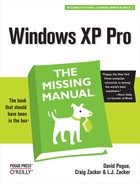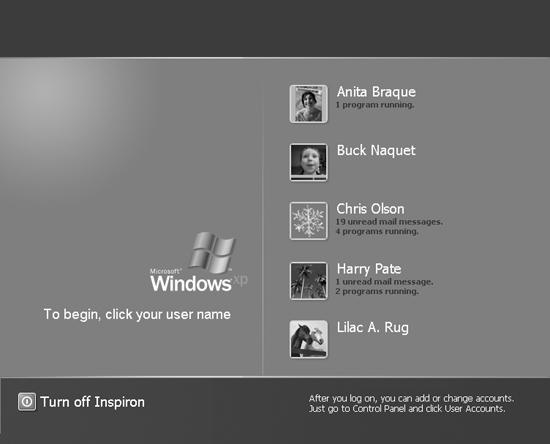On a Windows XP computer in a workgroup, the dialog box that greets you when you turn on the PC (or when you relinquish your turn at the PC by choosing Start→ Log Off) looks something like Figure 17-14. But a few extra controls let you, an administrator, set up the logon screen for either more or less security—or, put another way, less or more convenience.
Open the User Accounts program in the Control Panel, and then click “Change the way users log on or off.” As shown in Figure 17-12, Windows XP now offers you two extremely important logon options.
Under normal circumstances, the logon screen presents a list of account holders when the PC is first turned on, as shown in Figure 17-14.
If you’re worried about security, however, you might not even want that list to appear. If you turn off “Use the Welcome screen,” each person who signs in must type both his name and password into blank boxes—a very inconvenient, but secure, arrangement (Figure 17-13). (You can’t turn off “Use the Welcome screen” if Fast User Switching is turned on, as described in the next section.)
Tip
Even when you’re looking at the standard, friendly Welcome screen (Figure 17-14), you can switch to the older, Classic logon screen: just press Ctrl+Alt+Delete. (If you’re having trouble making it work, try pressing down the Alt key before the other ones.)
You may be used to using the Ctrl+Alt+Delete keystroke for summoning the Task Manager, as described in Section 5.3, but at the Welcome to Windows box, it means something else entirely.
If you’ve used any version of Windows before, the business about separate user accounts for everybody who uses a certain PC is old hat. One aspect of this feature, however, is dramatically new in Windows XP—and extremely welcome: Fast User Switching.
Suppose you’re signed in, and you’ve got things just the way you like them: You have eleven programs open in carefully arranged windows, your Web browser is downloading some gigantic file, and you’re composing an important speech in Microsoft Word. Now Chris, a co-worker/family member/fellow student, wants to duck in to do a quick email check.
In the old days, you might have rewarded Chris with eye-rolling and heavy sighs, or worse. If you chose to accommodate the request, you would have had to shut down your whole ecosystem, interrupting the download, closing your windows, saving your work and exiting your programs. You would have had to log off completely.
If Fast User Switching is turned on, however, none of that is necessary. All you have to do is press the magic keystroke, Windows logo key+L. (Or, if you’ve misplaced your keyboard, you can choose Start→Log Off, and then click Switch User in the Log Off dialog box.)
Now the Welcome screen appears, ready for the next person to sign in. Looking at the screen now, you may think you’ve just logged off in the usual way.
But look at it closely (Figure 17-14): You haven’t actually logged off at all. Instead, Windows has memorized the state of affairs in your account—complete with all open windows, documents, and programs—and shoved it into the background. Chris (or whoever) can now sign in normally, do a little work, or look something up. When Chris logs out again, the Welcome screen comes back once again, at which point you can log on again. Without having to wait more than a couple of seconds, you find yourself exactly where you began, with all programs and documents still open and running.
Figure 17-14. When Fast User Switching is turned on, you can call up the Welcome screen shown here without even quitting your programs and closing your windows. If Outlook Express or Windows Messenger is running, the Welcome screen even shows you how many unread email messages are waiting for you. (Point without clicking to produce a tooltip that breaks down which email accounts they came in on.)
This feature requires a good deal of memory, of course (don’t even think about it on a machine with less than 96 MB of RAM). Otherwise, however, it’s an enormous timesaver.
Tip
If Fast User Switching is turned off, its special keystroke—Windows logo key+L—is still special. Now it locks your PC, hiding all of your open programs and windows. The only thing on the screen is an Unlock Computer dialog box (which looks almost exactly like the one shown in Figure 17-14). At this point, nobody can even get into the machine except you or somebody with an Administrator account.
To turn on this optional feature, open the User Accounts program in the Control Panel. Click “Change the way users log on or off”; the dialog box shown in Figure 17-12 appears. Make sure “Use the Welcome screen” is turned on (it’s a requirement for Fast User Switching), and then turn on “Use Fast User Switching.” Finally, click the Apply Options button.
Note
You can’t turn Fast User Switching off if anybody else’s account is still open in the background. Before you can turn off the feature, you must first switch to each account in turn (press Windows key+L) and then sign off from each account.
Figure 17-15. Top: If you choose Start→Log Off when Fast User Switching is turned off, you get this limited dialog box. Bottom: When you choose Start→Log Off while Fast User Switching is turned on, you get this choice: you can either log off for real (click Log Off), or use Fast User Switching to cede control of the computer to another account holder and put your work into background memory (click Switch User).
From now on, you have two options each time you decide that you’re finished working for the moment. You can log off normally, closing all of your programs and windows—or you can fast switch, logging off temporarily, leaving your work open on the screen behind the scenes. Figure 17-15 shows you the difference.
Tip
Here’s the power user’s version of fast user switching (Administrator account required). Press Ctrl+Alt+Delete to open the Task Manager dialog box, whose Users tab reveals the list of logged-on accounts. Right-click the account you want, choose Connect from the shortcut menu, and boom!—you’re switched. You don’t even have to listen to the two-note musical switching theme.




